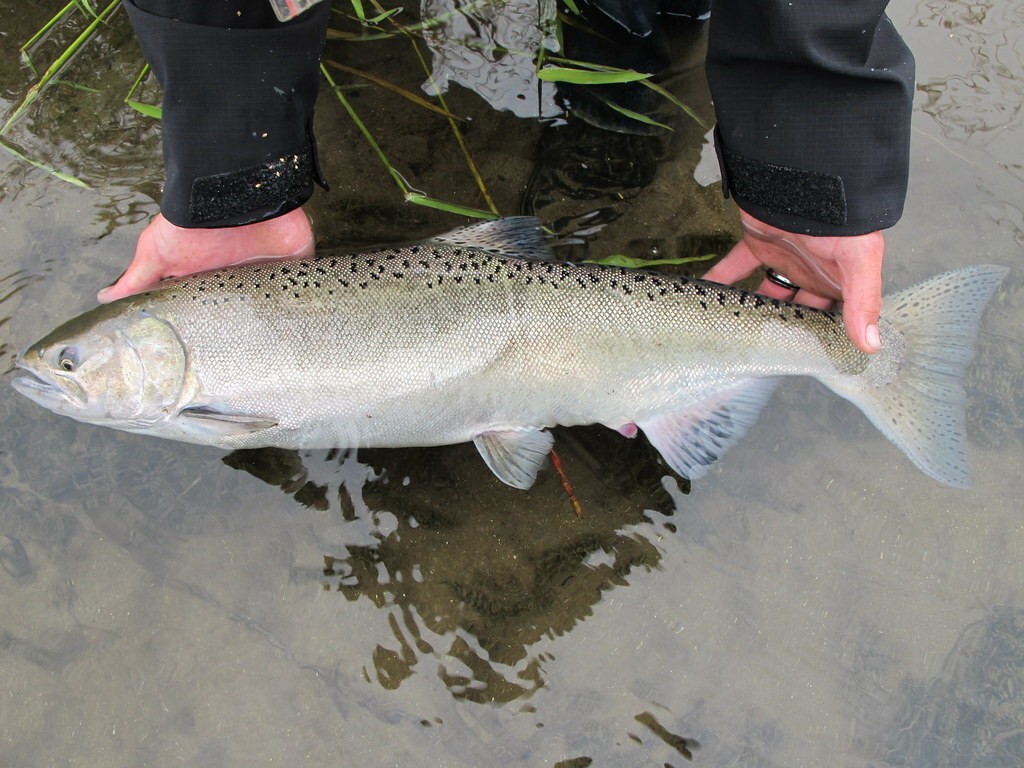
Your Source for Outdoor Adventure
Northern California and Southern Oregon
Simplified Salmon: The Reduced Resilience of the California Salmon Fishery

Photo Credit: FishBio
by FISHBIO
4-11-2022
“Keep it simple” is a commonly applied principle of design, but when it comes to ecosystems “keep it complicated” may be the better approach. Ecologists have long hypothesized that simplification of ecosystems reduces the climate resiliency of those ecosystems and the species that live in them. This process has proved challenging to document, but the extensive development, simplification, and degradation of California’s ecosystems over the past 170 years coupled with extensive monitoring data on the state’s salmon fishery provides an ideal opportunity to investigate this hypothesis. Researchers from the National Marine Fisheries Service recently leveraged this opportunity to search for empirical evidence of decreasing climate resilience in the California salmon fishery over the industrial era (Munsch et al. 2022). Their findings suggest that salmon populations of the past could weather unfavorable years by diffusing the impacts across diverse habitats, life histories, and time; however, human-driven homogenization of habitats and life histories has made the fishery of today far less resilient to an increasingly erratic climate.
Pacific salmon (Oncorhynchus species) express a wide diversity of migration patterns and timing, allowing them to take advantage of natural variation across landscapes and seasons. This diversity of life histories and the habitats that support them promote resilient fisheries, as it keeps production stable despite annual variation in climate conditions. Historically, the life cycles of four different Chinook salmon (O. tshawytscha) runs were spread across both the seasons and the landscape, and in turn the risk of climate-driven catastrophe was spread among them. Risk was also spread among years, as salmon reached maturity across a range of ages. All of these factors meant that long-term production was disconnected from volatile conditions in any given habitat, season, or year, which in turn made for a fishery that was more reliable than California’s chaotic climate.
The author’s review of the changes that have taken place in California over the past 170 years of industrialization describe a progressive reduction in the diversity of the ecosystem and the salmon populations it supports. Damming reduced the extent and diversity of habitats, commercial fishing reduced age diversity in salmon populations, and hatcheries released salmon over narrowing ranges of dates and life stages and homogenized stock genetics. Heaped atop these stressors is the current warming trend in California, and the authors hypothesize that the fishery’s ability to cope with this change has been severely curtailed by nearly two centuries of changes. The current fishery is nearly entirely dependent on fall-run, and this run includes a large proportion of juvenile fish that migrate to sea during the transition between spring and summer. This concentration of risk into a single life-history form with access to fewer habitats may cause the stock as a whole to be more heavily impacted by climate events, and transforming the Central Valley may have greatly increased the sensitivity of its salmon to temperature during the critical spring-summer transition period.
In an effort to find evidence to support these hypotheses, the authors developed models across various lengths of time to test for the presence of fishery-climate relationships, as well as for changes in these relationships. In visualizing historic time series, they found fishery performance was most affected by precipitation before widespread dam construction, but it was most influenced by air temperatures during the spring-summer transition after dams were completed. Further, climate effects were historically integrated into the fishery across a broader, four-year time frame, but this four-year climate signal has dwindled over time, and now fishery performance almost perfectly mirrors climate dynamics on an annual basis. The modern fishery exploits a population that is highly constrained in its ability to cope with climate variation, and this system is less capable of buffering the effects of years when conditions are poor.
The findings of this study are in line with fundamental ecological concepts that link the complexity of natural resources to their stability. Management actions that protect and restore the diversity of habitats and which promote diverse age structures in salmon populations may help to promote the resiliency of the fishery in the face of ongoing climate change. An unreliable resource can be just as significant of a problem as a scarce resource. Adapting to climate change will require moving away from highly simplified salmon production systems and restoring the diversity that historically allowed these fish to be resilient for thousands of years.
FISHBIO is a dedicated group of research scientists, engineers, and technicians that specialize in counting, tracking, and analyzing trends in fish and wildlife populations throughout the world. An expert staff, technical capacity, and state-of-the-art equipment make FISHBIO a trailblazer in aquatic research. For more information, please visit FISHBIO.com
MyOutdoorBuddy.com © 2025. All Rights Reserved.
Website Hosting and Design provided by TECK.net
Website Hosting and Design provided by TECK.net